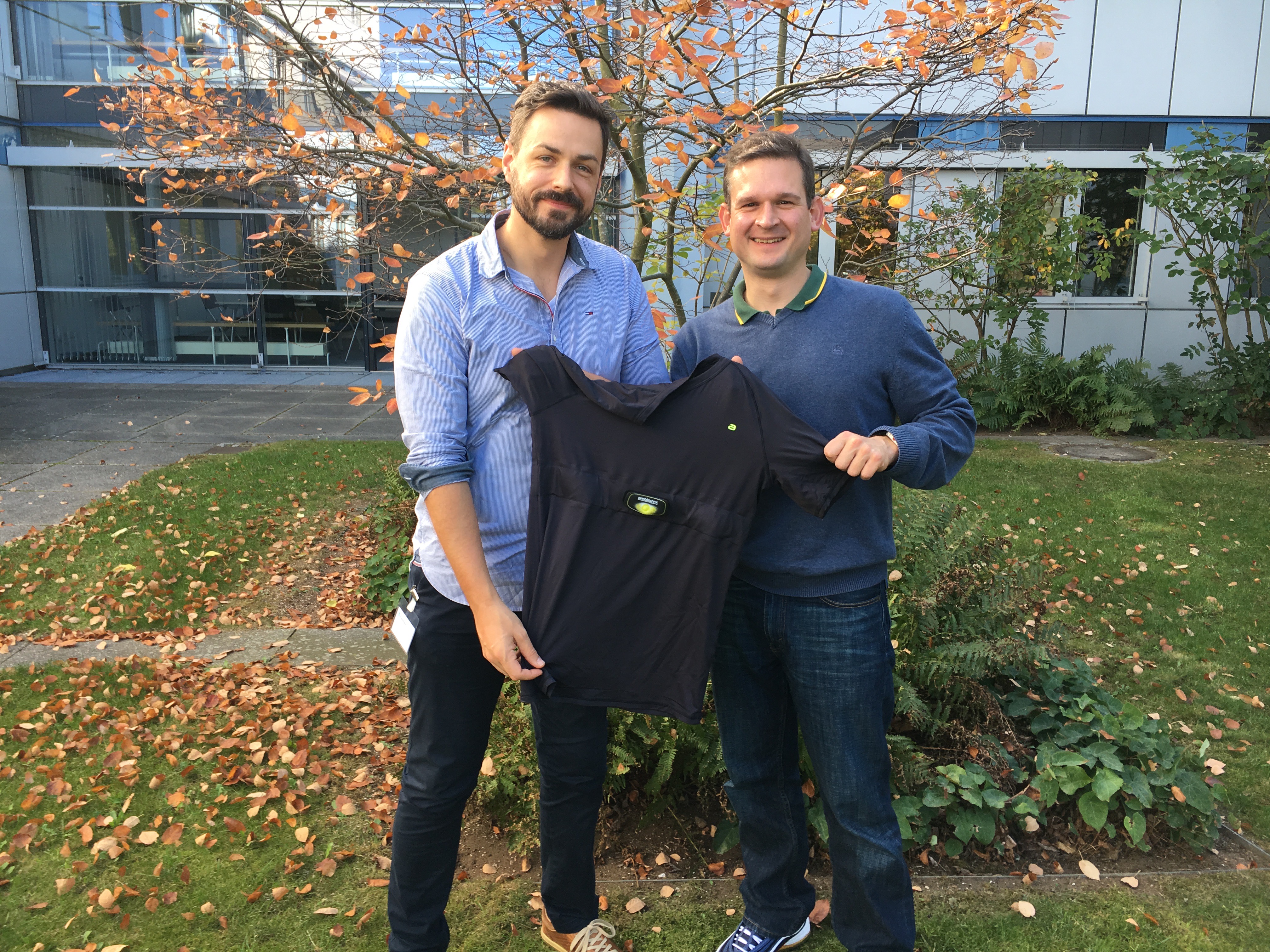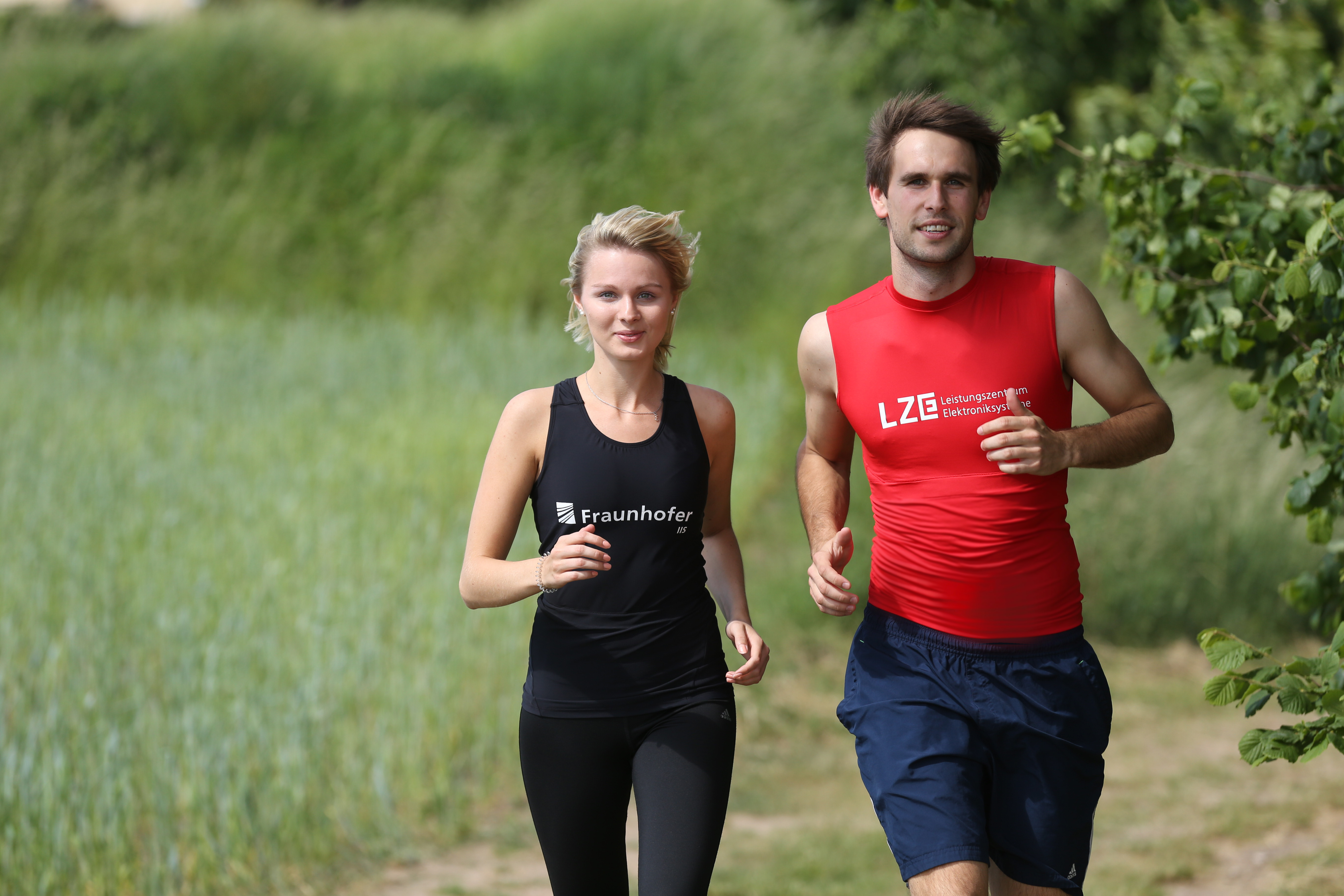With its FitnessSHIRT, Fraunhofer IIS has developed a prototype that can measure a range of different vital signs. The ambiotex company has turned the shirt into a market-ready product. In an interview, the company’s CEO Florian Dennerlein and Christian Hofmann from Fraunhofer IIS explain why the shirt is better than a sports watch, and what people who exercise can expect in the future.
“People with cardiac arrhythmia are often unaware that anything is wrong.”
https://www.iis.fraunhofer.de/en/magazin/2018/ambiotex.html


Mr. Dennerlein, you are the CEO of the company ambiotex. The “ambiotex shirt” is available in your web shop; it allows the wearer to measure parameters such as heart rate variability. Why is it better to measure these parameters with textiles, rather than with smartwatches that now have ECG capabilities?
Florian Dennerlein: Smartwatches can only take ECG readings if the wearer puts his or her other hand on the watch, because they need at least two points of contact along an imaginary line through the heart for a proper reading. If you’re experiencing symptoms, such as feeling dizzy or unwell, you can figure out for yourself when it would make sense to take a reading. Those are cases when a smartwatch can be used.
The approach behind our shirt is to provide continuous, medically precise monitoring for the wearer without impacting his or her daily life in any way. People with cardiac arrhythmia, for example, are often unaware that anything is wrong with their cardiac muscle, because they would need to be continuously monitored over the course of several weeks to rule out the possibility of an arrhythmia; a 24-hour ECG provided by a doctor often isn’t sufficient in this case.
Do you both exercise regularly, and if so, did that influence your choice of career or area of research?
Florian Dennerlein: A few years ago, I participated in a transalpine cycling race with just a few months of training; I basically went from zero to a hundred. After that, my body started to rebel. I had no idea I was overexercising. I didn’t have the antennae I needed to evaluate my own performance or capabilities. After the race, I decided to learn more about performance diagnostics. During my time at Fraunhofer IPA, I focused heavily on occupational health and safety and ergonomics, and I could picture myself working in heart rate and stress measurement in the future. Two weeks later, I got a call from an acquaintance who worked at an affiliate of ambiotex; he told me that they had a job opening for a product developer, so the job at ambiotex essentially fell into my lap, so to speak.
Christian Hofmann: As an engineer, I obviously enjoy collecting and processing good-quality data, making these data available, and helping to network medical applications. In addition to that, I’ve been a passionate cyclist since I was 14. My career allows me to combine my hobby and my work, and I’m really glad to have the opportunity to conduct research in this field at Fraunhofer IIS.
Mr. Hofmann, the market-ready product is based on the FitnessSHIRT, a prototype developed by Fraunhofer IIS. How did you come up with the idea of integrating electronics into a T-shirt? Did you have a “eureka moment,” or is the idea based on a longer development process?
Christian Hofmann: It was a longer process. The original intention was to make sensors available outside of the hospital environment, so that patients didn’t need to be hospitalized in order to be monitored. Our first step was to develop a mobile sleep laboratory. But the ultimate goal was to make sensors available in the patients’ day-to-day lives to track their vital signs even when they were on the go. Over time, we came up with the idea to integrate respiratory effort bands or ECG electrodes into items of clothing to appeal to a broader target group.
I remember one special moment particularly clearly; it was after the development process was complete and the shirt was already on the market. I was at a conference on smart homes and wearable sensors. When the keynote speaker mentioned out of nowhere that she was wearing our FitnessSHIRT right at that very moment, I was completely surprised. At that point, I knew we were on the right track. My face absolutely lit up when that happened.
How did the collaboration between ambiotex and Fraunhofer IIS come to pass?
Christian Hofmann: We had a booth at MEDICA 2013 where we presented our prototype. We were approached there, and we worked with Florian’s predecessors Thomas Claussen and Klaus Bscheid to develop the concept and the goal of marketing the FitnessSHIRT commercially. ambiotex was founded shortly after that to help us achieve this goal.
What are the next steps for the shirt? What sort of improved exercise management systems can tech-savvy people who exercise regularly expect from the technology in the future?
Florian Dennerlein: We already have a basic set of analyses. What we’re still missing is a way to automatically interpret the data or automatically generate exercise plans. Over the long term, we also want to break into the occupational health and safety field, where the shirt could be used to help warn of dangerous situations.
How can Fraunhofer IIS provide support for that process?
Christian Hofmann: At the Leistungszentrum Elektroniksysteme (LZE), we are currently working on monitoring the effort expended during exercise by measuring sweat using the “ELECSA” sensor. It’s a noninvasive alternative to the infamous blood lactate measurements – it doesn’t require the presence of medical staff, and the patient doesn’t even need to interrupt his or her workout. The technology essentially already works in the lab, but for portable use, we still have a few tricky kinks to work out; we’re also looking for partners for further development.
Mr. Dennerlein, Mr. Hofmann, thank you for taking the time to speak with us today.
Brief Profiles
Florian Dennerlein studied bioinformatics in Tübingen. He has worked at ambiotex since 2015 and has served as CEO since February 2016. Previously, he was a research associate at the Fraunhofer Institute for Manufacturing Engineering and Automation IPA in the Biomechatronic Systems department, where he headed the biomechanical motion laboratory.
Christian Hofmann has worked at Fraunhofer IIS since 2003 and is head of the Medical Sensor Systems group. He studied electrical engineering at Friedrich-Alexander University Erlangen-Nuremberg.